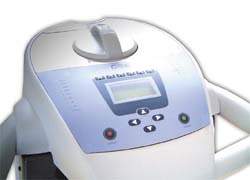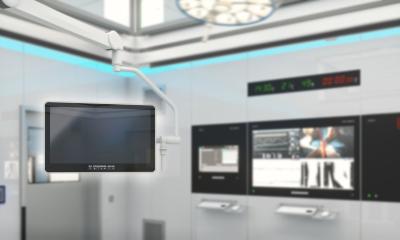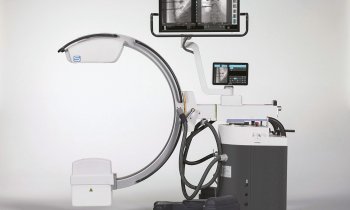Britain: The big bug buster
Brenda Marsh presents just a few of the technologies and strategies used to combat dangerous pathogenic resistance
The UK's MRSA rates have been declining since 2006 — and this year could be 50% lower than in 2004. This increasing control over dangerous pathogens has not been achieved without considerable hospital staff efforts, relentless public and government pressures on them, and in-house malcontent about the out-sourcing of cleaning work.
Given the cost of nosocomial infections to patients, the NHS has developed many practices to be followed — for example operation `deep clean´ — and it spends a lot on developing various strategies, promotions as well as equipment to promote more stringent hygiene. Here are just a few measures taken as well as debates currently in the UK news.

French robots join UK battle
A small army of six robots (to be augmented by a cohort of six, in total costing around )106,000) will soon arrive to emit a dry mist to attack any pathogenic micro-organisms in three hospitals in England’s Midlands.
A Norovirus outbreak in a ward at Sandwell General Hospital last December subsequently spread throughout the hospital. In April visitors to all adult wards (excluding paediatrics and maternity) had to be banned. Stringent hygiene and a ‘deep clean’ followed.
After testing a Sterinis Robot on a ward, the NHS Trust responsible for this and two other Midlands hospitals estimated it would take 16 of the robots to clean a single ward in two hours, but they found the robot was also very effective in cleaning side rooms, bays and even ambulances. When the robots arrive, the Trust plans to use them as well as a deep clean.
Made by Gloster Santé, based in Toulouse, France, the Sterinis Robot uses a patented dry-fog diffusion technology to release particles of electrically-charged ultra-high performance hydrogen peroxide (H2O2)-based disinfectant. The particles stick to anything, the mist carrying them everywhere, onto curtains, beneath beds, into cupboards, even concealed or inaccessible areas, there to eradicate pathogenic organisms, the firm reports, adding that no room furnishings or equipment need be removed before a robot ‘invasion’. Such an onslaught is reported to be effective in destroying MRSA, C Diff, e-coli, Norovirus, listeria, salmonella, etc.
Along with automatic monitoring and operating systems, which require no human presence during the robots work, the equipment also incorporates a traceability system, so that disinfecting operations can be recorded and a log edited via the unit’s USB port.
The Sterinis process meets all the requirements of the Biocide Directive CE 98/8, Gloster Santé adds. ‘It is neither corrosive nor toxic, and is 99.99% biodegradable.’
Glow and show inspection
Using long wave ultraviolet light the Hand Inspection Cabinet (also called the Glow and Show machine) highlights hygiene problems after washing, enabling infection control officers to help train staff in correct hand washing or scrubbing techniques. A lotion called Glitter Bug, or a powder, is applied to the hands and then washed off. When placed in the cabinet any remaining lotion on hands fluoresces under the UV lamp.
Recently, Suffolk-based DaRo UV Systems Ltd redesigned this device. The main body is now made in one-piece and is no longer textured black, but now a smooth metallic silver colour to make lotion spills easier to wipe off. ‘It also provides better light reflection for greater disclosure of poor hand cleansing,’ DaRo says, ‘…and, it’s generally more ascetically pleasing!’ adds DaRo. The larger viewing area also makes training easier.
Among users for teaching purposes, Vicki Parkin, Head of Infection Control at York Hospital — reported to have the lowest number of outbreaks of secondary infection (e.g. MRSA) in the UK – believes in the cabinet’s valuable. ‘Every infection control unit must have it, because it’s visually the only way people can see how easily infection can spread.’
Get the message?
The UK’s official 2007 MRSA rates showed that the Heart of England NHS Foundation Trust (HENHSF) had reduced MRSA infections more than any other Trust in the country. The HENHSF award-inning Infection Control Team at Heartlands Hospital have certainly neither been short on efforts or of ideas to reduce those numbers.
This May it was commended by Ecolab, which produces Spirigel’s alcohol gel, for using more of this product than any other UK clients – 61,000 ml in 2007 compared to 5,000 ml in 2006.
During HENHSF’s two-week intensive Cleanyourhands campaign, inspired by the film Ghostbusters, members of the promotional team (pictured) manned the main entrance of the hospital wearing boiler suits and proton packs. There they gave visitors alcohol hand gel, urging them to use it upon entering the building. Inside, visitors also found posters, life-size cardboard models and eight foot display screens to remind them, as well as patients, of how to combat unwanted pathogens.
CHANGING CONCEPTS
Killing MRSA by curbing cannulae
One highly notable development could find itself a paradigm to be adopted nationally and internationally.
Although in 2007-08 the Winchester and Eastleigh Healthcare NHS Trust had reported 11 bacteraemia infections (the government’s maximum ‘acceptable’ level is 12). Yet, in the last seven months the Trust’s two hospitals have reported not one case of MRSA infections, including bacteraemia and wound infections. Why?
Traditionally, new patients were automatically set up with cannulae for intravenous injections. However, last November a new procedure was launched in which only a doctor can prescribe cannula use and its insertion must be performed only by trained specialists. Once in situ the tube is flushed with saline solution and then checked daily by a doctor, who records its appearance and any irregularities.
Outsourcing must be ousted
Despite the government giving hospital cleaning high priority status and its recent implementation of a ‘deep cleaning’ programme for all NHS hospitals in England, as well as its infection strategy (pub. January) that says quality cleaning is essential, a high number of doctors and nurses are far from satisfied that outsourcing of ward cleaning and instrument cleansing to private companies works.
Instruments - Currently, the government is encouraging NHS Trusts to use private decontamination centres for instrument sterilisation. However, a survey of surgeons, by the Royal College of Surgeons of England (RCS) has revealed country-wide concern that some surgical procedures have to be cancelled due to problems with outsourcing. Two thirds of the 250 respondents said they were unhappy about either the condition of returned instruments (damage) or the lateness of their return — or even non-return — from their out-source centres.
ENT surgeon Professor Richard Ramsden, who worked on the survey, emphasised that the study indicates that ‘…surgeons working with on-site instrument cleaning facilities are getting a better service, enough to warrant an urgent reassessment of what’s best for the NHS’.
Ward cleaning – Back in the 80s, private cleaning firms began to receive hospital contracts. Today they undertake about 40% of NHS hospital cleaning. This is not satisfactory, said participants at the recent Royal College of Nursing Conference, indeed for one the equation looked straightforward: ‘There has been an increase in hospital infections and decline in cleanliness. It’s quite simple.’
The nurses blamed poor cleaning results on a higher turnover among company supplied cleaners, their low training level and less commitment to the hospital. In-house cleaners are more committed because they feel ‘part of the NHS family’ and ‘an essential part of the team’, nurses pointed out. Another participant reported that NHS Trusts in the north-west has found their own answer: they are bringing cleaning back in-house. The nurses voted ‘overwhelmingly’ for action to end cleaning contracts with private companies and bring hospital cleaning back in-house generally.
* The Department of Health has pointed out that there is no evidence of a difference in quality, or infection rates, between hospitals with in-house or out-sourced cleaning services.
01.07.2008






